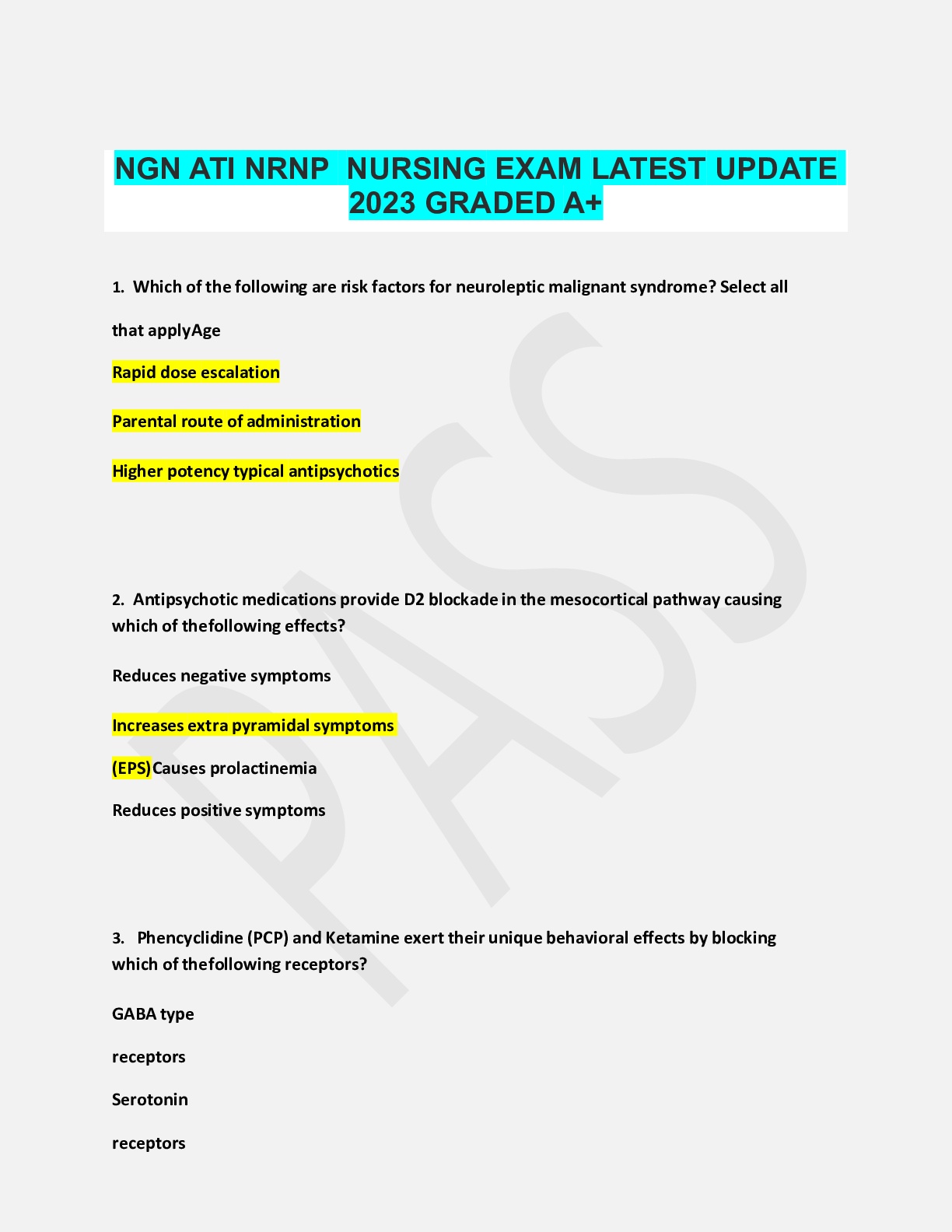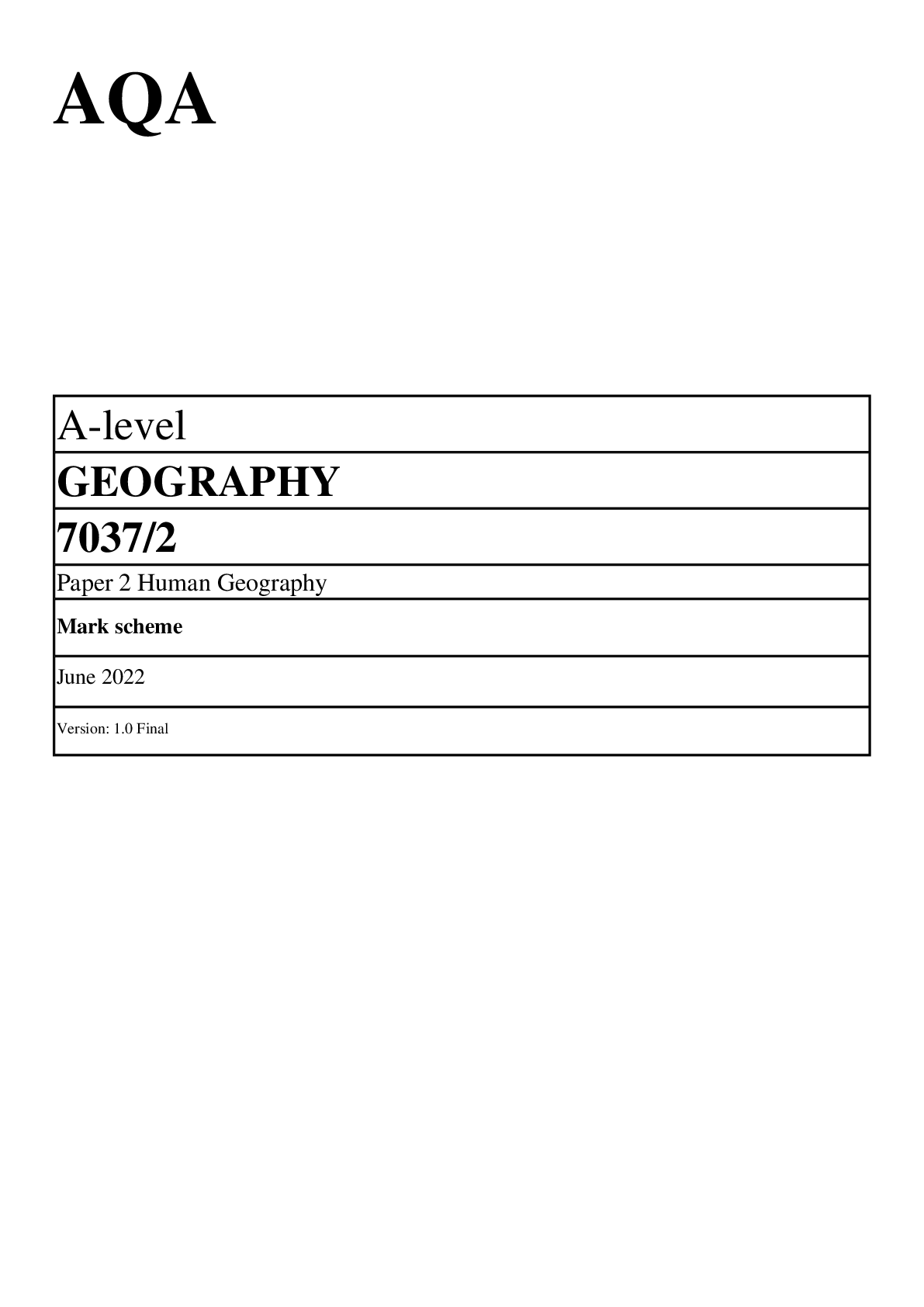
NGN ATI NRNP NURSING EXAM LATEST uPDATE 2023 GRADED A+
$ 16
.png)
A-Level Physics 7408/3BA - Paper 3 Section B - Astrophysics Final
AQA > A-Level Mark Scheme > AQA A-level GEOGRAPHY 7037/2 JUNE 2022 MARK SCHEME > Human Geography (All)
A-level GEOGRAPHY 7037/2 Paper 2 Human Geography Mark scheme June 2022 Version: 1.0 Final *226A7037/2/MS* Mark schemes are ... prepared by the Lead Assessment Writer and considered, together with the relevant questions, by a panel of subject teachers. This mark scheme includes any amendments made at the standardisation events which all associates participate in and is the scheme which was used by them in this examination. The standardisation process ensures that the mark scheme covers the students’ responses to questions and that every associate understands and applies it in the same correct way. As preparation for standardisation each associate analyses a number of students’ scripts. Alternative answers not already covered by the mark scheme are discussed and legislated for. If, after the standardisation process, associates encounter unusual answers which have not been raised they are required to refer these to the Lead Examiner. It must be stressed that a mark scheme is a working document, in many cases further developed and expanded on the basis of students’ reactions to a particular paper. Assumptions about future mark schemes on the basis of one year’s document should be avoided; whilst the guiding principles of assessment remain constant, details will change, depending on the content of a particular examination paper. Further copies of this mark scheme are available from aqa.org.uk Copyright information AQA retains the copyright on all its publications. However, registered schools/colleges for AQA are permitted to copy material from this booklet for their own internal use, with the following important exception: AQA cannot give permission to schools/colleges to photocopy any material that is acknowledged to a third party even for internal use within the centre. Copyright © 2022 AQA and its licensors. All rights reserved. Level of response marking instructions Level of response mark schemes are broken down into levels, each of which has a descriptor. The descriptor for the level shows the typical performance for the level. There are marks in each level. Before you apply the mark scheme to a student’s answer read through the answer and annotate it (as instructed) to show the qualities that are being looked for. You can then apply the mark scheme. The notes for answers provide indicative content. Students’ responses may take a different approach in relation to that which is typical or expected. It is important to stress that examiners must consider all a student’s work and the extent to which this answered the question, irrespective of whether a response follows an expected structure. If in doubt the examiner should contact their team leader for advice and guidance. Step 1 Determine a level Start at the lowest level of the mark scheme and use it as a ladder to see whether the answer meets the descriptor for that level. The descriptor for the level indicates the different qualities that might be seen in the student’s answer for that level. If it meets the lowest level then go to the next one and decide if it meets this level, and so on, until you have a match between the level descriptor and the answer. With practice and familiarity you will find that for better answers you will be able to quickly skip through the lower levels of the mark scheme. When assigning a level you should look at the overall quality of the answer and not look to pick holes in small and specific parts of the answer where the student has not performed quite as well as the rest. If the answer covers different aspects of different levels of the mark scheme you should use a best fit approach for defining the level and then use the variability of the response to help decide the mark within the level, ie if the response is predominantly level 3 with a small amount of level 4 material it would be placed in level 3 but be awarded a mark near the top of the level because of the level 4 content. Step 2 Determine a mark Once you have assigned a level you need to decide on the mark. The descriptors on how to allocate marks can help with this. The exemplar materials used during standardisation will help. There will be an answer in the standardising materials which will correspond with each level of the mark scheme. This answer will have been awarded a mark by the Lead Examiner. You can compare the student’s answer with the example to determine if it is the same standard, better or worse than the example. You can then use this to allocate a mark for the answer based on the Lead Examiner’s mark on the example. You may well need to read back through the answer as you apply the mark scheme to clarify points and assure yourself that the level and the mark are appropriate. Indicative content in the mark scheme is provided as a guide for examiners. It is not intended to be exhaustive and you must credit other valid points. Students do not have to cover all of the points mentioned in the indicative content to reach the highest level of the mark scheme. An answer which contains nothing of relevance to the question must be awarded no marks. Section A Qu Part Marking guidance Total marks 01 1 Outline threats to Antarctica from fishing and whaling. Point marked Allow 1 mark per valid point with extra mark(s) for developed points (d). For example: Notes for answers Allow credit for specific knowledge and understanding of the threats to Antarctica from fishing and whaling. Candidates may also consider the extent to which the threats are mitigated. Candidates can gain maximum marks from covering fishing or whaling, there is no requirement to consider both. • Antarctica marine waters are highly productive due to the Antarctic Convergence where the upwelling and mixing creates waters rich in oxygen and nutrients (1). This makes them highly lucrative for fishing businesses and over-fishing has occurred (1) (d). • Many species of whales have been over-exploited (1). However, the threat is now less due to the establishment of the IWC which banned commercial whaling globally in 1982 (1). However, some nations such as the Japanese still whale under the guise of scientific research (1) (d). • Overfishing of krill removes a major supply of food as it is low down in the food chain (1). It is a popular protein food in SE Asia and commands high prices (1) (d). This demand is making fishing of krill in the Southern Ocean unsustainable (1) (d). • Illegal fishing is of grave concern in the Southern Ocean as it is difficult to control and manage for organisations such as ASOC (1). The long- line fishing of the Patagonian Toothfish (1) has caused a massive depletion of stocks but also resulted in the deaths of sea-birds due to loss of a food source (1) (d). • Fishing ships are also responsible for ocean pollution, often dumping fishing gear and waste into the ocean (1). The cold water temperatures are slow to break down pollutants (1) (d). • Fishing and whaling boats have brought in invasive species on the hull of their ships (1) such as the Mytilus bivalve (1) (d). The notes for answers are not exhaustive. Credit any valid points. 4 AO1 = 4 [Show More]
Last updated: 2 years ago
Preview 1 out of 46 pages

Buy this document to get the full access instantly
Instant Download Access after purchase
Buy NowInstant download
We Accept:

Can't find what you want? Try our AI powered Search
Connected school, study & course
About the document
Uploaded On
May 22, 2023
Number of pages
46
Written in
All
This document has been written for:
Uploaded
May 22, 2023
Downloads
0
Views
126
Scholarfriends.com Online Platform by Browsegrades Inc. 651N South Broad St, Middletown DE. United States.
We're available through e-mail, Twitter, Facebook, and live chat.
FAQ
Questions? Leave a message!
Copyright © Scholarfriends · High quality services·